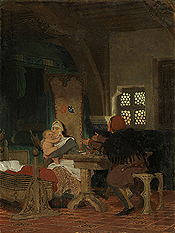X
Please wait for the PDF.
The browser will either open the file, download it, or display a dialog.
The browser will either open the file, download it, or display a dialog.

This article analyzes the local and global networks of the commercial art trade that dialectically informed the conditions of the art market in London over the course of the second half of the nineteenth century. This analysis is achieved through a ground-breaking application of digital humanities tools: spatial mapping and network visualization. The article intends to advance both revisionary studies of the rise of the art dealer in nineteenth-century Europe and the application of modes of inquiry associated with the digital humanities to art history.
This article offers a new reading of John Everett Millais's A Huguenot (R. A. 1852), referencing the work's reception in the periodical press, theorizations of the projection of narcissistic masculine desire in nineteenth-century art, and investigations of the interdependence of the domestic and public sphere. It argues that Millais's painting can be read as a complex articulation of the conflicts that shaped middle-class masculinity in the mid-nineteenth century.
In the mid-to late 1880s, a little-known Japanese painter named Aoki Toshio arrived in San Francisco, where he made a name for himself as T. Aoki, a painter, newspaper and magazine illustrator, and public storyteller. As a Japanese painter in California, Aoki was subject to prejudice from both Japanese and Americans, each of whom endeavored to situate him within a different set of social identities and artistic styles. This article assesses his positionality and works, asking what they reveal about the international circuits of Japonisme and Japanese art in the late nineteenth-century.
A scandal shook Danish art when Jens Ferdinand Willumsen exhibited his etching Frugtbarhed in 1891. A heavily pregnant woman—Willumsen's wife, Juliette—and a short text about a new language of art flank a grain, which sprouts in a way that looks less like a plant than some sort of diagram. This article discusses Willumsen's etching in the context of evolutionary theory, arguing that Willumsen is a rare example of an artist who not only let the theory of evolution fuel his artistic imagination, but also concerned himself with a core issue of the theory, namely to what extent it could be applied to the language of art.
Paul Cézanne's Mary Magdalen (Sorrow) was painted in the 1860s on the walls of his family's home, the Jas de Bouffan. This article considers afresh its unorthodox painting style in light of a revival of interest in the seventeenth-century Provençal poet, Pierre de Saint-Louis, whose epic poem on Mary Magdalen was seen by Théophile Gautier to push the boundaries of good taste to the point of genius. With regard to the Provençal cult of Mary Magdalen, the article also looks at a ceremony to mark the translation of the saint's relics at the basilica of Saint-Maximin-la-Sainte-Baume in May 1860.
From the 1840s onwards, a steady stream of British artists, writers, and botanists began to visit the secluded enclave of Darjeeling where they were instantly drawn to the vaporous formations of Himalayan mist gliding across its mountain slopes. If these formations appealed to the senses, they did so because they produced a wide array of spectral imaginings while catering to the picturesque love of visual surprise. This article examines how the mutability of Himalayan vapor was rendered palpable through the aesthetic schemata of the picturesque, and how its chiaroscuro effects triggered deep-seated concerns about restoring a robust British constitution and character amid fears of "going native."
The history of comics is usually traced back to caricature; artists such as William Hogarth, Thomas Rowlandson, and Rodolphe Töpffer are touted as the genre's originators. In this article the author proposes a parallel route for the development of comics, going back to popular prints, specifically the Images d'Epinal in France.









